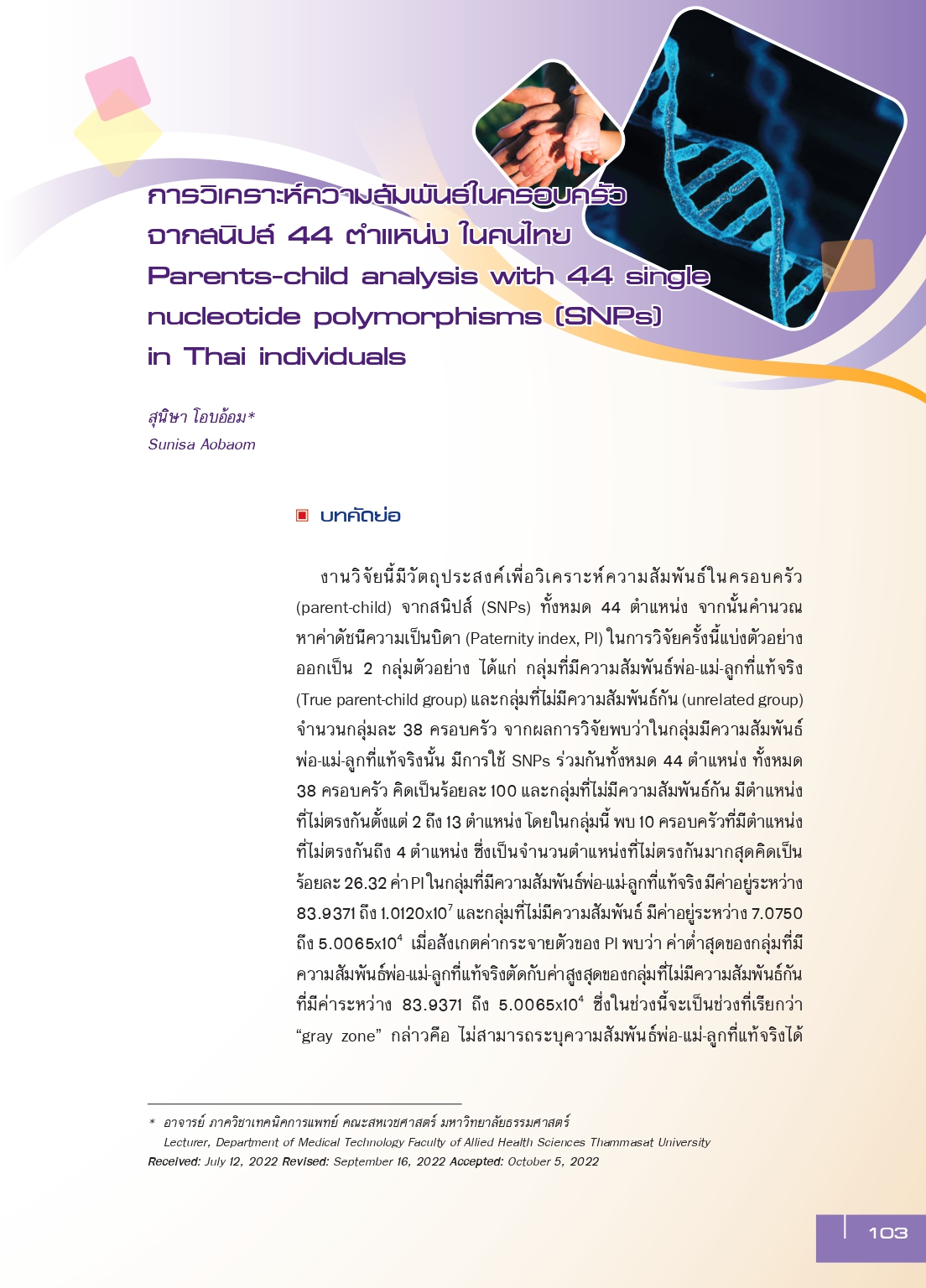การวิเคราะห์ความสัมพันธ์ในครอบครัวจากสนิปส์ 44 ตำแหน่ง ในคนไทย
Main Article Content
บทคัดย่อ
งานวิจัยนี้มีวัตถุประสงค์เพื่อวิเคราะห์ความสัมพันธ์ในครอบครัว (parent-child) จากสนิปส์ (SNPs) ทั้งหมด 44 ตำแหน่ง จากนั้นคำนวณหาค่าดัชนีความเป็นบิดา (Paternity index, PI) ในการวิจัยครั้งนี้แบ่งตัวอย่างออกเป็น 2 กลุ่มตัวอย่าง ได้แก่ กลุ่มที่มีความสัมพันธ์พ่อ-แม่-ลูกที่แท้จริง (True parent-child group) และกลุ่มที่ไม่มีความสัมพันธ์กัน (unrelated group) จำนวนกลุ่มละ 38 ครอบครัว จากผลการวิจัยพบว่าในกลุ่มมีความสัมพันธ์พ่อ-แม่-ลูกที่แท้จริงนั้น มีการใช้ SNPs ร่วมกันทั้งหมด 44 ตำแหน่ง ทั้งหมด 38 ครอบครัว คิดเป็นร้อยละ 100 และกลุ่มที่ไม่มีความสัมพันธ์กัน มีตำแหน่งที่ไม่ตรงกันตั้งแต่ 2 ถึง 13 ตำแหน่ง โดยในกลุ่มนี้ พบ 10 ครอบครัวที่มีตำแหน่งที่ไม่ตรงกันถึง 4 ตำแหน่ง ซึ่งเป็นจำนวนตำแหน่งที่ไม่ตรงกันมากสุดคิดเป็นร้อยละ 26.32 ค่า PI ในกลุ่มที่มีความสัมพันธ์พ่อ-แม่-ลูกที่แท้จริง มีค่าอยู่ระหว่าง 83.9371 ถึง 1.0120x107 และกลุ่มที่ไม่มีความสัมพันธ์ มีค่าอยู่ระหว่าง 7.0750 ถึง 5.0065x104 เมื่อสังเกตค่ากระจายตัวของ PI พบว่า ค่าต่ำสุดของกลุ่มที่มีความสัมพันธ์พ่อ-แม่-ลูกที่แท้จริงตัดกับค่าสูงสุดของกลุ่มที่ไม่มีความสัมพันธ์กันที่มีค่าระหว่าง 83.9371 ถึง 5.0065x104 ซึ่งในช่วงนี้จะเป็นช่วงที่เรียกว่า “gray zone” กล่าวคือ ไม่สามารถระบุความสัมพันธ์พ่อ-แม่-ลูกที่แท้จริงได้ ซึ่งค่า PI ของกลุ่มที่ไม่มีความสัมพันธ์ เกิดจากคำนวณโดยการตัดตำแหน่งที่ไม่ตรงกันออกและคำนวณค่า PI ดังกล่าว งานวิจัยนี้แสดงให้เห็นว่าพบความแตกต่างจากการใช้ SNPs 44 ตำแหน่ง ระหว่างกลุ่มที่มีความสัมพันธ์พ่อ-แม่-ลูกที่แท้จริง (True parent-child group) และกลุ่มที่ไม่มีความสัมพันธ์กัน (unrelated group) สามารถช่วยทำนายความสัมพันธ์ของมนุษย์และนำไปประยุกต์ใช้กับความสัมพันธ์ในเครือญาติอื่น ๆ ในอนาคตได้
Article Details

อนุญาตภายใต้เงื่อนไข Creative Commons Attribution-NonCommercial-NoDerivatives 4.0 International License.
ต้นฉบับที่ได้รับการตีพิมพ์ในวารสาร เป็นลิขสิทธิ์ของวารสารกระบวนการยุติธรรม แต่ความคิดเห็นที่ปรากฏในเนื้อหาของบทความในวารสารกระบวนการยุติธรรม ถือเป็นความรับผิดชอบของผู้เขียนแต่เพียงผู้เดียว
เอกสารอ้างอิง
Agena Bioscience. (2021). Variant List – Sample ID Panel. Retrieved January 13, 2021, จาก https://agenabio.com/products/panel/iplex-pro-sample-id-panel/
Borsting, C., Sanchez, J. J., Hansen, H. E., Hansen, A. J., Bruun, H. Q., & Morling, N. (2008). Performance of the SNPforID 52 SNP-plex assay in paternity testing. Forensic Science International: Genetics, 2(4), 292-300.
Buckleton, J. S., Bright, J. A., & Taylor, D. (2016). Forensic DNA evidence interpretation (2nd ed.). United States: CRC Press.
Butler, J. M. (2005). Forensic DNA typing : biology, technology, and genetics of STR markers (2nd ed.). United States: Elsevier Academic Press.
Cho, S., Shin, E. S., Yu, H. J., Lee, J. H., Seo, H. J., Kim, M.Y., & Lee, S. D. (2017). Set up of cutoff thresholds for kinship determination using SNP loci. Forensic Science International: Genetics, 29, 1-8.
Elkins, K. M. (2013). Chapter 18 - Human Genetic Analysis: Paternity or Missing Persons Cases and Statistics. In: Elkins K. M. (Ed.). Forensic DNA Biology. San Diego, Academic Press.
Kim, J. J., Han, B. G., Lee, H. I., Yoo, H. W., & Lee, J. K. (2010). Development of SNP-based human identification system. International Journal of Legal Medicine, 124(2), 125-131.
Lee, P. M. (2012). Bayesian statistics : An introduction (4th ed.), United State: Wiley.
Liu, X., Zhao, Z., Xu, Q., Zhang, J., & Li, C. (2019). Analysis of full- and half-siblings using a combined system of STR, InDel and SNP markers. Forensic Science International: Genetics Supplement, 7(1), 349-350.
Lou, C., Cong, B., Li, S., Fu, L., Zhang. X., & Feng, T., et.al. (2011). A SNaPshot assay for genotyping 44 individual identification single nucleotide polymorphisms. Electrophoresis, 32(3-4), 368-78.
NCBI. (2021). dbSNP Allele Frequency of Homo sapiens (Asian). ค้นเมื่อ 26 ตุลาคม 2021, จากhttps://www.ncbi.nlm.nih.gov/snp/
Sanchez, J. J., Phillips, C., Børsting, C., Balogh, K., Bogus, M., & Fondevila, M., et.al. (2006). A multiplex assay with 52 single nucleotide polymorphisms for human identification. Electrophoresis, 27(9), 1713-24.
Sun, S., Liu, Y., Li, J., Yang, Z., Wen, D., & Liang, W., et.al. (2020). Development and application of a nonbinary SNP-based microhaplotype panel for paternity testing involving close relatives. Forensic Science International: Genetics. 46, 102255.
Yamane, T. (1973). Statistics: an introductory analysis. New York: Harper& Row.
Yousefi, S., Abbassi-Daloii, T., Kraaijenbrink, T., Vermaat, M., Mei, H., & van‘t Hof, P., et.al. (2018). A SNP panel for identification of DNA and RNA specimens. BMC Genomics, 19(1), 90.
Zhang, Q., Zhou, Z., Wang, L., Quan, C., Liu, Q., & Tang Z., et.al. (2020). Pairwise kinship testing with a combination of STR and SNP loci. Forensic Science International: Genetics, 46, 102265.


